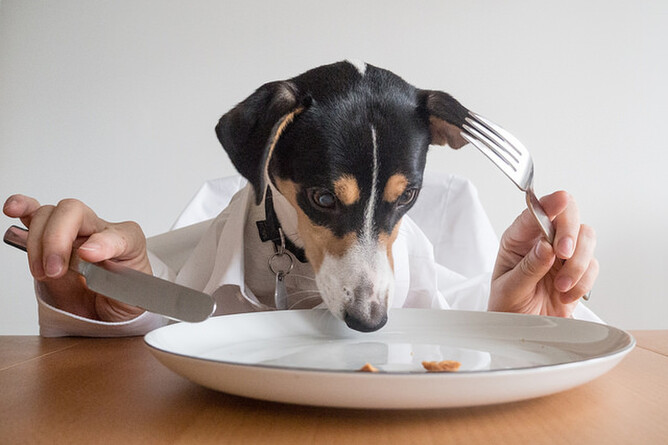Photo courtesy of Georgie Pauwels
Dig into these doggy diet tips!
A healthy dog diet means a stronger, more energetic pup, and most importantly, more years to spend with your best friend.
But when it comes to deciding what to feed our hungry pooches, the information out there can often be overwhelming. From dog food brands marketing “gourmet” and “premium” foods to experts claiming there’s benefits to be gained from a raw dog food diet, it’s hard to know what’s right for your pup. But don’t worry, we’ve got a few tips to help you decide how to best feed your furry friend.
1) Tackling dry food vs. canned
While your pup might know their preference between dry and canned, is one really better than the other?
Canned foods are generally higher in protein with less preservatives. Dry food, on the other hand, is often just as high in nutrients as canned and can help strengthen dog's teeth. While canned food tends to be better for older dogs with sensitive teeth, kibble can be great for satisfying your pup’s chewing habits.
When it comes down to it, there isn’t a huge a huge nutritional difference between dry food and canned. As long as you're choosing a trusted brand with natural ingredients, your pup will benefit. So, hey, why not try mixing them together?
2) Read the label for more info
It’s easy to get sucked into tasty marketing on commercial dog food, but what’s really in the big brand stuff? Trying to decipher the label can be a headache, but it’s important to know what’s really in the food your dog is chowing down on ..
Have a look at the top ingredients listed. The items listed first make up the majority of mix. Look for whole foods like chicken over vague-sounding animal protein descriptions, and watch out for too many preservatives and additives.
3) Watch your portions
We all know, the way to a dog’s heart is through their stomach -- but rewarding your pup with tasty treats and extra helpings can be damaging. Try using a measuring cup every time you dish out your dog’s dinner.
4) Don’t forget to let them drink up!
Make sure your pup is getting plenty of water. The amount of water they’ll need will depend on their size. Though the average 25kg dog should be drinking about 1.6 litres a day.
Different feeds for different breeds?
Should a pug have a different diet to a german shephard?
While it would seem that different breeds of dogs should eat differently, it’s more important to focus on what your own dog needs. A younger pup will have a different diet to an adult, and a small dog will eat less than a big one.
So what shouldn’t you feed your dog?
While your pup might jump at the chance to nibble on whatever food is lying around, they’re probably not thinking about whether it’ll trigger allergies, damage their teeth, or give them food poisoning.
Like us humans, dogs can been prone to food allergies so it’s important to keep an eye on their overall health. Common signs of food allergies can be: itching, bald patches and skin infections. Other foods may even prove fatally toxic.
Some foods to avoid:
- Dairy. Most dogs are lactose intolerant so watch out for milk, yoghurt and icecream.
- Walnuts and macadamias. Be careful, these are extremely poisonous for pups!
- Chocolate. Popular knowledge is correct. Chocolate contains a component that’s toxic for dogs.
- Onions and garlic. These veggies can cause damage to your dog’s red blood cells, causing anemia.
If you're finding your pup scratching away after he chows down on his dinner, then it might be time for a check up with the vet and change in diet.
The great thing is that there’s loads of healthy food alternatives so your pooch will never go hungry. Look for more natural dog food with less ingredients, or even try making some homemade treats. You can ask us for recipes check the blog for ones we’ve already shared.
Raw food diet -- is it better for your pup?
It’s a common debate in the doggy community: is a raw food diet better for your pup?
First of all, what is a raw food diet? It all started with Australian vet Ian Billinghurst in the early 1990s proposing a new diet of Bones and Raw Food (BARF). He based it off the kinds of high protein, uncooked foods that dogs would have eaten before they became domesticated.
For those in the raw food camp, the benefits are higher energy levels, shinier coats and stronger, cleaner teeth.
Raw foods can include:
- Raw beef, chicken or fish
- Bones
- Raw eggs
- Vegetables
But what about the raw food diet dangers? While there are some benefits to BARF, there are also some important health risks to consider:
- Risk food poisoning from Salmonella, E. Coli and other parasites present in raw meats
- Choking hazards from bones as well as damage to gums
- Difficulty digesting raw vegetables.
If you do decide to follow a raw food diet, make sure you’re getting high quality meats, preparing them safely and balancing with fresh vegetables your vet has cleared for consumption.
If you’re still not sure what foods are best, we can help. We offer high quality dry and canned food options. Pop in store to check out our range!

